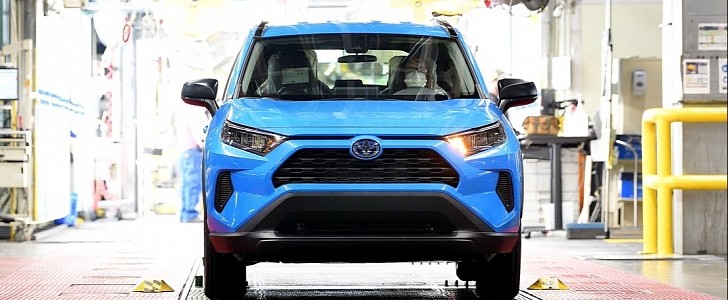The semiconductor crunch has hit the automotive industry hard. So much so that even the dealers are feeling the brunt of the chip shortage as their inventories dry up with each passing day. Because of these circumstances, new vehicles sold almost a week faster in June 2021 compared to May.
iSeeCars.com analyzed more than a million vehicles from the 2016 to 2020 model year, and Toyota dominates the list of fastest-selling new cars with the RAV4. The compact SUV took 9.5 days to sell on average while the fuel-sipping hybrid and plug-in hybrid took 11.1 and 12 days, respectively.
“The RAV4 has seen renewed interest thanks to the success of the PHEV, which had its best-ever monthly sales in June, leading some dealers to mark up its price due to high demand,” highlighted executive analyst Karl Brauer.
As expected, U.S. motorists can’t get enough of used cars either. The fastest-selling used vehicle in June 2021 is the Tesla Model 3 with 17.6 days on average. What’s even more interesting about the iSeeCars.com study is the average price of a used Model 3 all-electric sedan, specifically $45,653 as opposed to $39,990 for a brand-spanking-new Standard Range Plus. “Model 3s are so popular that consumers are willing to purchase used cars that were more expensive than new versions of the vehicle,” added Brauer.
In addition to the automotive industry, the chip shortage also affects Tesla Powerwall production. Current demand exceeds 80,000 units but the Palo Alto-based outfit won’t be able to make even half that amount this quarter.
As to why the automotive industry bleeds money over the semiconductor crunch, you can blame the virus that shall not be named for this blunder. Historically speaking, automakers have limited inventories of parts to just-in-time to reduce costs. When new-vehicle sales took a turn for the worse last year during lockdown, many semiconductor foundries decided to switch production from automotive chips to consumer electronics, especially chips that demand higher prices such as the specialized chips for 5G connectivity.
According to analysts, the shortage will continue into Q1 of 2022.
“The RAV4 has seen renewed interest thanks to the success of the PHEV, which had its best-ever monthly sales in June, leading some dealers to mark up its price due to high demand,” highlighted executive analyst Karl Brauer.
As expected, U.S. motorists can’t get enough of used cars either. The fastest-selling used vehicle in June 2021 is the Tesla Model 3 with 17.6 days on average. What’s even more interesting about the iSeeCars.com study is the average price of a used Model 3 all-electric sedan, specifically $45,653 as opposed to $39,990 for a brand-spanking-new Standard Range Plus. “Model 3s are so popular that consumers are willing to purchase used cars that were more expensive than new versions of the vehicle,” added Brauer.
In addition to the automotive industry, the chip shortage also affects Tesla Powerwall production. Current demand exceeds 80,000 units but the Palo Alto-based outfit won’t be able to make even half that amount this quarter.
As to why the automotive industry bleeds money over the semiconductor crunch, you can blame the virus that shall not be named for this blunder. Historically speaking, automakers have limited inventories of parts to just-in-time to reduce costs. When new-vehicle sales took a turn for the worse last year during lockdown, many semiconductor foundries decided to switch production from automotive chips to consumer electronics, especially chips that demand higher prices such as the specialized chips for 5G connectivity.
According to analysts, the shortage will continue into Q1 of 2022.














